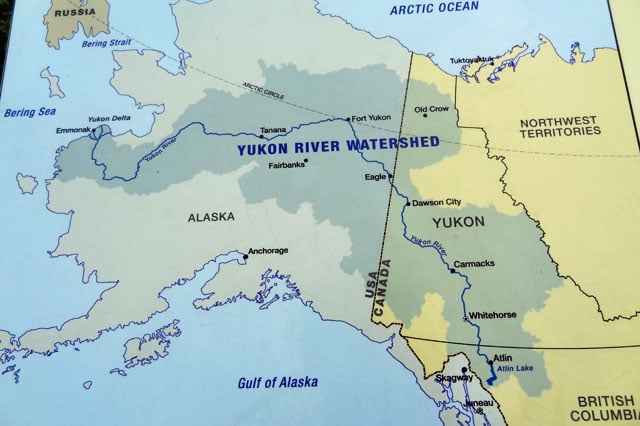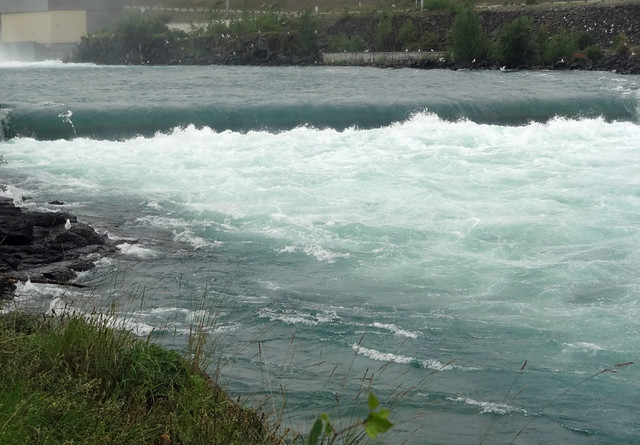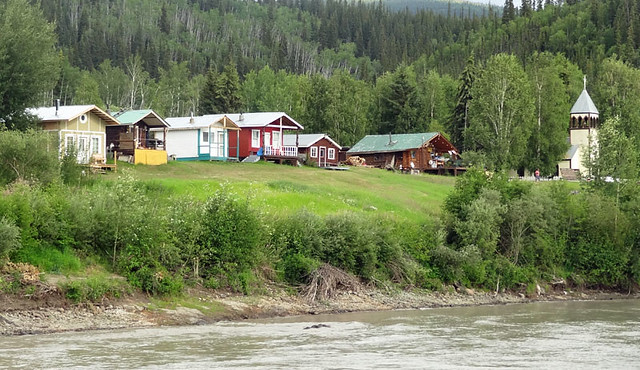
As a seasoned Chicago driver, I thought I had seen it all when it came to rush hour headaches and unforgiving traffic jams. But the Yukon had a surprise for me!
In Dawson City, the Yukon River flows through the spot where the Klondike and Top of the World Highways meet.
While most modern communities would erect a bridge to allow traffic to pass from one side to the other, here they’ve opted to use a 24/7 ferry service to shuttle pedestrians and motorists across the river.
The ride only takes about five minutes, and it’s a relaxing trip across the Yukon that fits right in with the area’s non-hurried lifestyle.
But on rare busy days, like when the Dawson City Music Festival brings several hundred visitors to town, the wait for the ferry can be lengthy.

Our group sat for half an hour while we waited our turn, eventually getting on the third ferry across. Such a backup would cause mass chaos and road rage in Chicago, but here, the ferry is an accepted part of life.
There’s been talk of finally getting a bridge, but some folks actually prefer this quaint system because it adds character. In the winter, when the river freezes, the ferry system stops and people are able to drive their cars and snow machines across the natural ice bridge. How cool is that?
The Dawson City ferry is just one of the ways in which this waterway impacts life throughout the territory. If you want to understand the Yukon, you have to understand the Yukon River.
The Yukon River, History and Present
In the late 1890s, the Yukon River was the primary means of reaching Dawson City during the Klondike Gold Rush.
Today, the river is the place to be for historic attractions, hiking and camping opportunities, and leisurely dinner cruises.
The Yukon starts in the northern part of British Columbia and flows north, working its way up to Whitehorse, Yukon’s capital city. It continues past Dawson and then heads west into Alaska, where it flows into the Bering Sea.
The Yukon is the third longest river in North America, behind the Mississippi and the Mackenzie River of the Northwest Territories.

In Whitehorse, a number of trails follow the river. One of the most popular is the Millennium Trail, the closest to town.
I completed the 5 km loop that starts on the edge of downtown and works it way out to the dam before circling back to the start.

One of the best parts of this hike is the chance to look up at the giant bald eagle nest. This particular spot became such a common annual eagle hangout that the city once set up a camera so that people could watch the nest via live stream.
I’m amused by the disclaimer attached to the stream: “The actions of the eagles in this video feed could contain graphic content.” They define killing and eating fish as graphic content – just in case anyone would be offended by such a thing.
From below, the nest looks massive and the eagles can sometimes be seen towering over the edge. These are two of the three babies that were born last summer – their heads aren’t white yet.

The dam is impressive, and the speed and power of the river are evident while standing along the shore. You do not want to mess with this river.

Yukon River attractions and cruises
Whitehorse is the home of the SS Klondike, the historic ship that once transported people and cargo from Whitehorse to Dawson and back.
The paddle steamboat on display is actually the Klondike II, built in 1937 to replace the first one, which ran aground the previous year.
The vessel has been restored and is now a Parks Canada historic attraction. It’s 210 feet long and 42 feet wide, with five different levels.

The restored ship allows guests to enter the freight hold, engine room, crew’s quarters, kitchen, dining room, and upper observation decks.

While kayaking and canoeing are possible on the Yukon, this is not a place for beginners, due to the strong current.
A better way for those without sporting backgrounds to experience the river is on a Klondike Spirit dinner cruise from Dawson City.

Visit the Whitehorse Fish Ladder to see chinook salmon returning to their homes. This is the longest salmon migration in the world (2000 miles), and the ladder allows them to avoid the rushing water of the dam.
For me, the highlight of the Spirit cruise was the chance to see Moosehide, a settlement located just downriver from Dawson.
Back in the gold rush days, when tens of thousands of white settlers came up from the south and took over Dawson, the local Tr’ondek Hwech’in First Nation moved its community to Moosehide to preserve its identity.
They lived in the village until the 1950s. Celebrations and events still take place here, and some buildings are now being restored and rebuilt.

While you’re in the Yukon, try your hand at panning for gold or joining the Sourtoe Cocktail Club. I suggest visiting the Yukon in July or August.
Note: My visit to Canada’s Yukon territory was made possible by Tourism Yukon.


